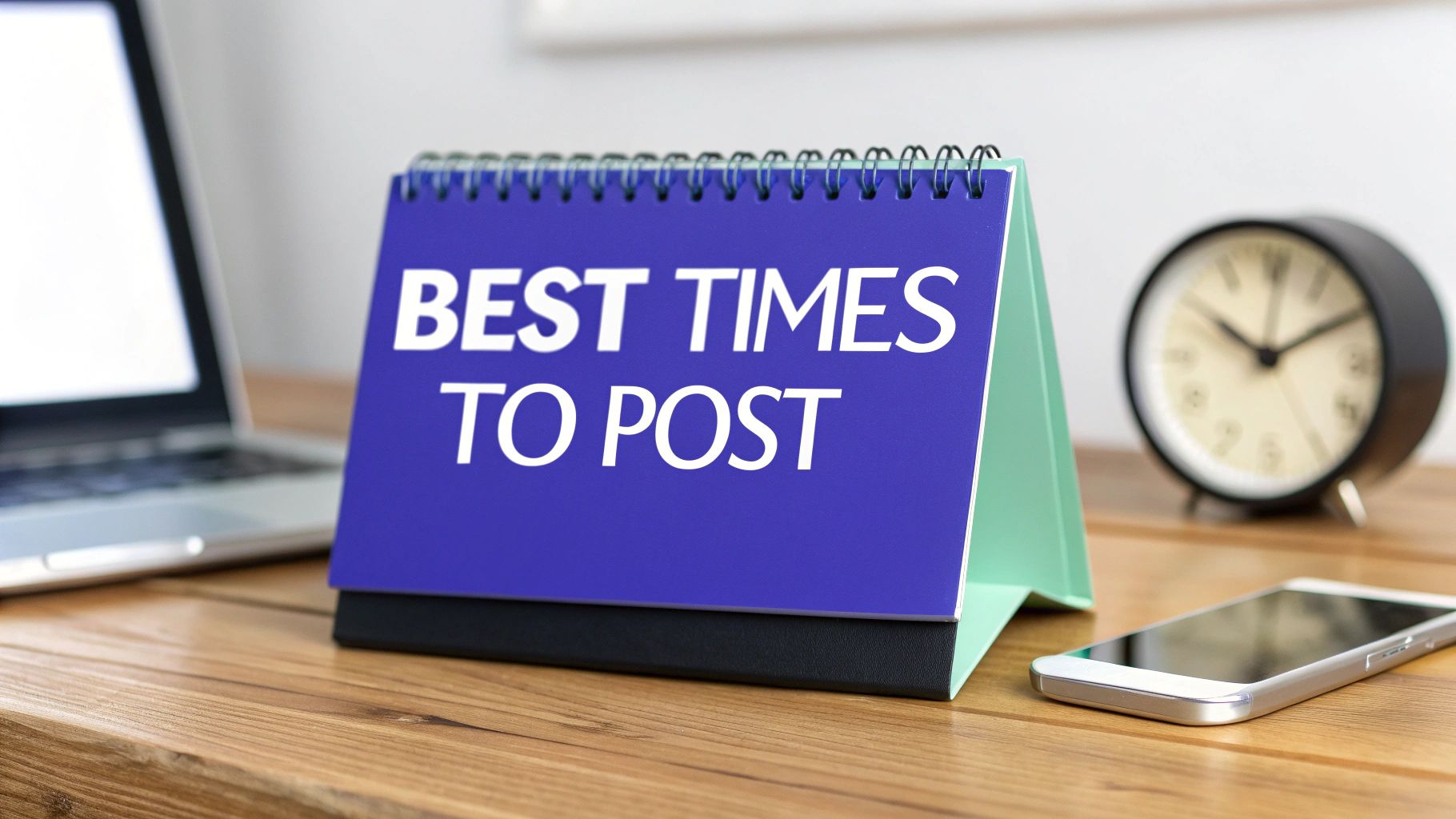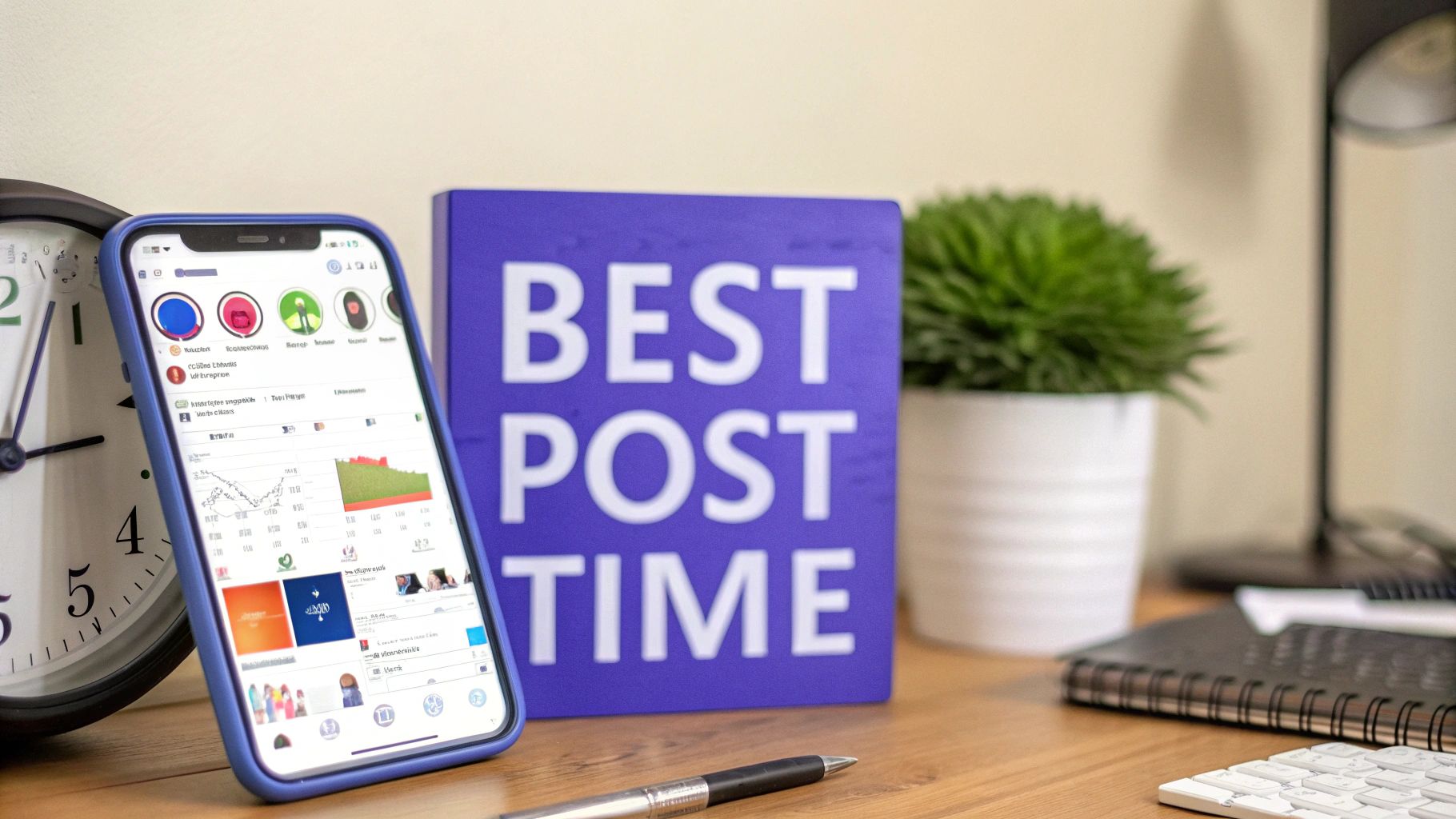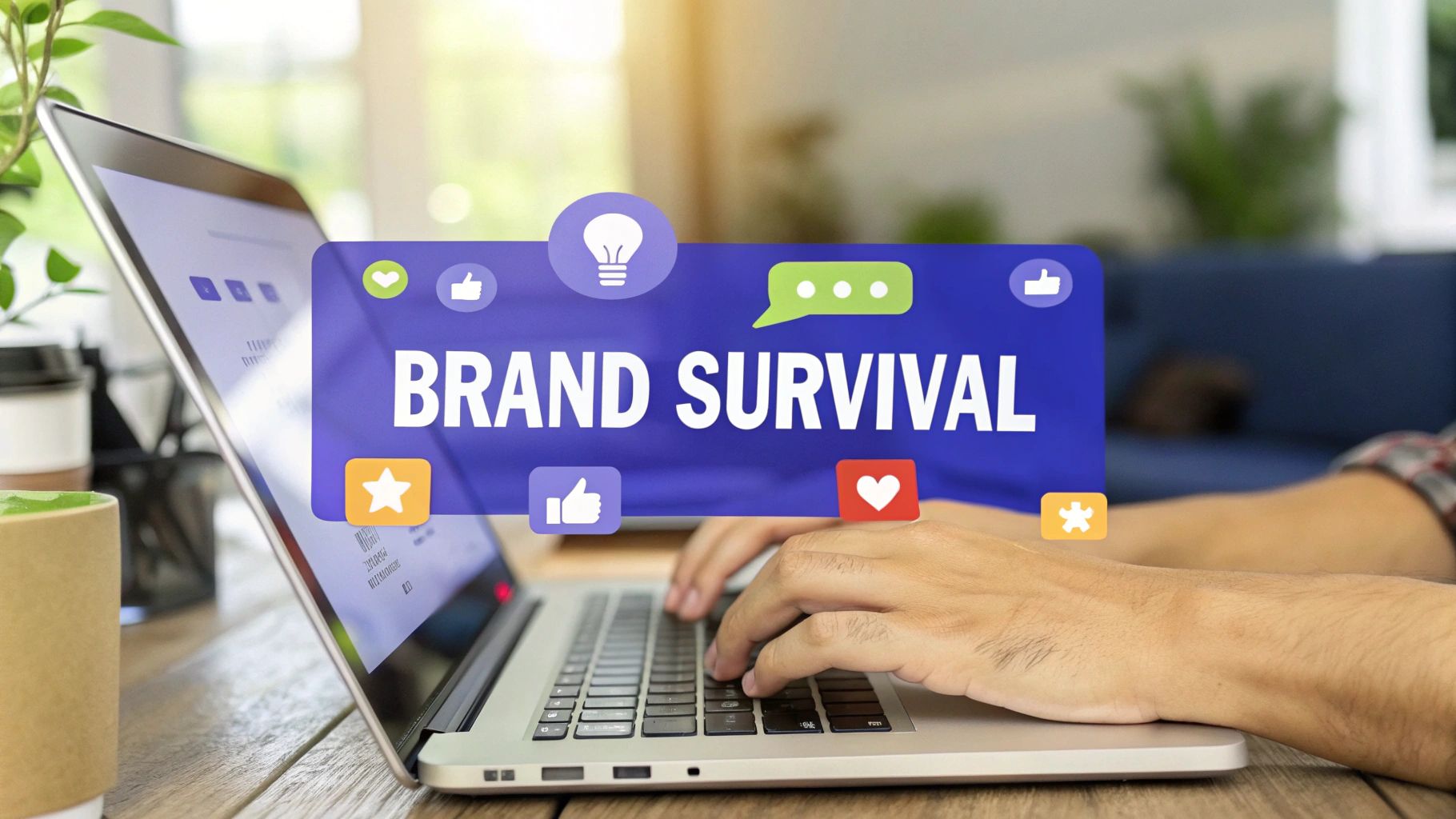In the crowded landscape of social media, what you post is only half the battle. When you post can be the deciding factor between content that soars and content that gets lost in the digital noise. Generic advice no longer cuts it. To truly maximize your reach, engagement, and ROI, you need a data-driven strategy that understands audience behavior, platform algorithms, and specific time-based opportunities.
Knowing the best times to post is about more than just hitting 'publish' during peak hours; it's about aligning your message with the precise moments your audience is most receptive. Vague advice like 'post on weekdays' is a starting point, but it lacks the nuance required for standout performance. True optimization comes from understanding the psychology behind user habits, from the morning commute scroll to the evening wind-down browse.
This guide moves beyond the obvious, providing actionable insights for different industries and platforms. We will cover seven proven, data-backed strategies for identifying the absolute best times to post your content for maximum impact. You will learn how to:
- Capitalize on specific windows like the morning commute and lunch breaks.
- Pinpoint the optimal days and times for both B2B and B2C audiences.
- Adapt your schedule for different social media platforms.
- Use your own audience analytics to uncover unique posting opportunities.
More importantly, we'll show you how to leverage powerful tools like PostSyncer's AI-driven scheduling to automate this process, ensuring your content consistently hits the mark without manual guesswork. Get ready to transform your social media calendar from a simple schedule into a strategic weapon for growth.
1. Peak Commute Time Posting (7-9 AM)
One of the most consistently effective strategies for social media engagement is to capture your audience during their first digital check-in of the day. The 7-9 AM window, often referred to as the morning commute, represents a prime opportunity to connect with users as they browse their phones over breakfast, on public transport, or before settling into their work or school day. This is a foundational tactic for determining the best times to post because it targets a highly engaged, albeit distracted, audience looking for quick, valuable content to start their morning.
Pioneering research from industry leaders like Buffer and Hootsuite consistently highlights this timeframe's value. It’s when users are most receptive to content that is either motivational, educational, or newsworthy, setting the tone for their day.
Why This Time Slot Works
The power of the 7-9 AM window lies in established daily routines. People are creatures of habit, and for millions, this habit involves scrolling through social feeds on platforms like LinkedIn, Instagram, and X (formerly Twitter). During this period, users are actively seeking information and distraction. A well-timed post can insert your brand directly into this crucial morning ritual, making it the first piece of industry content your audience consumes. This early engagement often leads to higher visibility throughout the day as platform algorithms favor content that gains initial traction quickly.
Key Insight: The morning commute window isn't just about being seen; it's about being the first brand your audience meaningfully interacts with, establishing relevance for the rest of the day.
Actionable Strategies for Implementation
To capitalize on this peak time, your content must be tailored for a mobile-first, on-the-go audience.
- Focus on Scannable Content: Use eye-catching visuals, short video clips, or infographics. Think of a fitness influencer posting a "Morning Motivation" graphic or a B2B tech company sharing a quick, insightful statistic.
- Test and Refine Your Timing: The 7-9 AM window is broad. Use analytics to determine if your specific audience is more active at 7:15 AM or 8:30 AM. Schedule posts at different 15-minute intervals to pinpoint your unique sweet spot.
- Align Content with Platform Mindset:
- LinkedIn: Post industry news, career advice, or company updates around 8 AM. Microsoft, for example, has seen significant engagement boosts by posting thought leadership pieces during this slot.
- Instagram: Share inspiring visuals, behind-the-scenes stories, or quick tutorials. This is a prime time for user-generated content features.
- News & Media: Outlets like CNN and The New York Times push their top headlines across social platforms during these hours to capture peak traffic.
Leveraging a robust scheduling tool is essential for consistency. You can explore how PostSyncer’s tools simplify this process and help you automate your morning posts with our guide on social media scheduling software. By planning ahead, you ensure your content is perfectly timed to meet your audience right where they are, every single morning.
2. Lunch Break Engagement (12-1 PM)
Capitalizing on the midday lull, the 12-1 PM window offers a unique opportunity to connect with an audience actively seeking a mental break. This lunch hour slot is a critical component for determining the best times to post, as it targets professionals, students, and general users who step away from their primary tasks to scroll, relax, and catch up on their social feeds. This timeframe is ideal for content that is entertaining, easily digestible, or provides a quick value-add during a brief period of downtime.
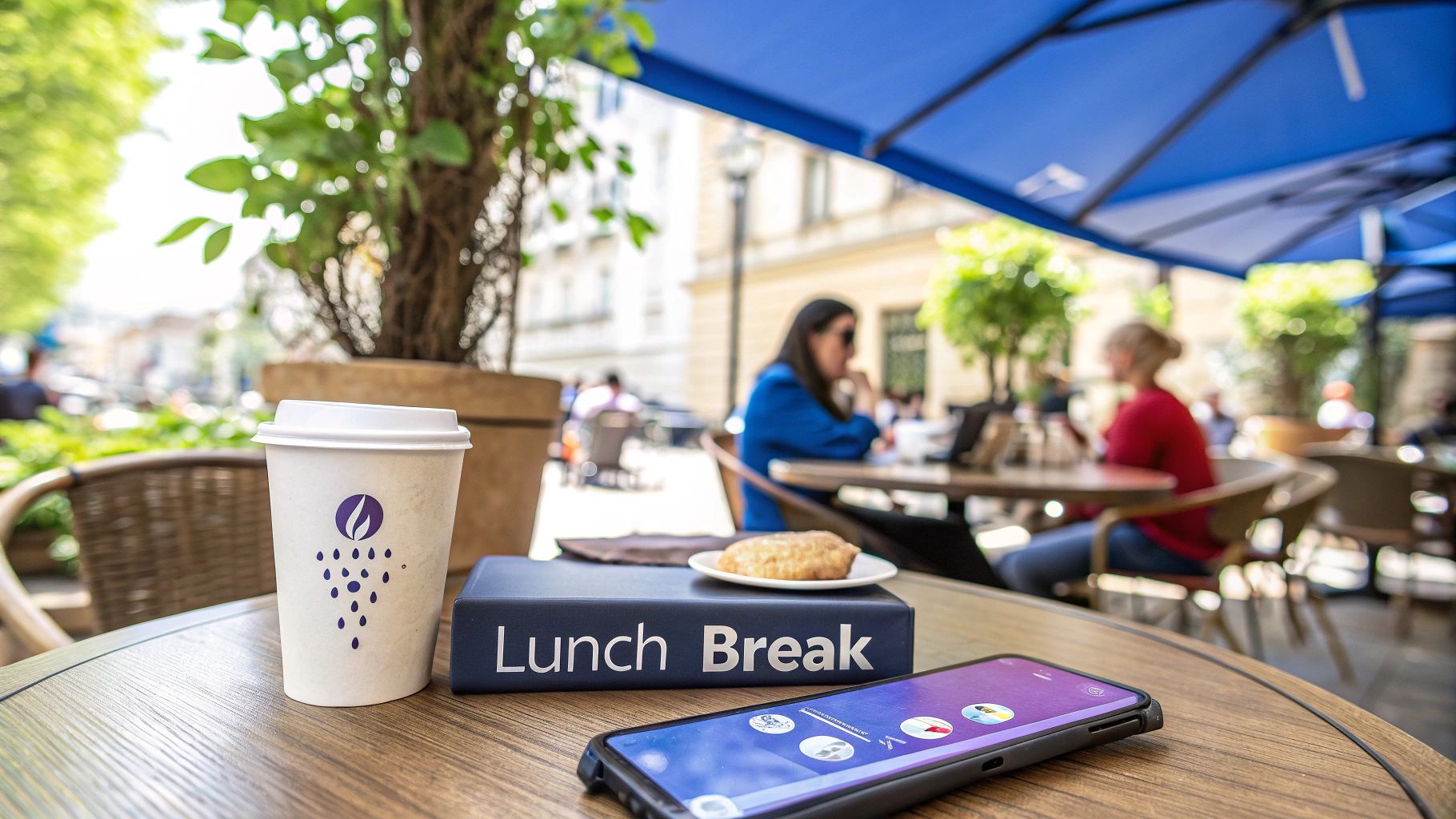
This strategy is consistently validated by data from major social media analytics platforms. In-depth research from Sprout Social and CoSchedule frequently points to this midday peak, while Later's analysis often highlights its effectiveness for visually-driven platforms like Instagram, where users look for quick, engaging content during their break.
Why This Time Slot Works
The effectiveness of the 12-1 PM slot is rooted in the psychology of a typical workday or school day. After several hours of focused work, the brain seeks a rewarding distraction. Social media perfectly fills this need, offering a quick escape. By posting during this window, your content can become the go-to source of that midday mental refresh. This is a time when users are less likely to be deep in work-related tasks and more open to consuming lighter, more engaging content, from humorous videos to interesting listicles or quick news updates.
Key Insight: Lunch break posting allows you to capture your audience at their peak point of daily disengagement from work, making them more receptive to content that entertains, informs, or inspires.
Actionable Strategies for Implementation
To win the lunch break scroll, your content needs to be immediate, compelling, and perfectly suited for quick consumption.
- Prioritize Concise and Consumable Content: This audience has limited time. Think short recipe videos, quick "how-to" guides, engaging polls, or visually striking infographics. The goal is to deliver value in under a minute.
- Use Compelling Hooks: Lead with a strong headline, a question, or a surprising statistic to grab attention instantly. A B2B brand could ask, "What’s the one productivity hack you need this afternoon?" to spark immediate engagement.
- Align Content with Platform and Audience Mindset:
- Facebook/Instagram: This is prime time for lifestyle brands. Food Network, for example, has seen exceptional engagement by posting recipe videos just before noon, inspiring what people might eat for lunch.
- LinkedIn: SaaS companies like Slack can share quick productivity tips or post thought-provoking questions related to workplace culture, catching professionals during their break.
- X (formerly Twitter)/TikTok: Brands like BuzzFeed excel here by posting lighthearted listicles, quizzes, and viral-style videos that are perfect for a quick, entertaining scroll.
Remember to consider time zones, especially for a global audience. Scheduling posts to hit the 12-1 PM window in multiple key regions can significantly amplify your reach and engagement. By carefully timing your posts for this midday opportunity, you can turn a simple lunch break into a powerful touchpoint for your brand.
3. Evening Wind-Down (6-8 PM)
As the workday concludes, a second major opportunity for engagement opens up. The 6-8 PM window, known as the evening wind-down, captures users as they transition from work life to personal time. This is when people have more mental bandwidth and leisure time to consume content more deeply, making it one of the best times to post for engagement that goes beyond a simple "like." Users are settling on the couch, looking for entertainment, and are more willing to watch longer videos, read detailed posts, and participate in community discussions.
This prime-time slot is heavily endorsed by major platforms and data-driven marketers. Key resources like YouTube's Creator Academy and Facebook Business insights consistently identify these evening hours as a period of high activity and sustained attention, particularly for video-centric and community-focused content.
Why This Time Slot Works
The effectiveness of the 6-8 PM slot is rooted in user behavior and psychology. After a long day, users turn to social media for relaxation, entertainment, and social connection. Unlike the morning rush, where content must be quick and scannable, evening users are in a mindset to invest time. This creates a perfect environment for longer-form content like detailed tutorials, in-depth discussions, or streaming premieres that demand more than a few seconds of attention. Engagement during this period is often more meaningful, leading to higher comment rates, shares, and conversions.
Key Insight: The evening wind-down is not about capturing fleeting glances; it's about securing dedicated attention. This is your chance to build community and foster deeper connections with content that entertains, educates, or inspires.
Actionable Strategies for Implementation
To succeed in this competitive time slot, your content must be compelling enough to serve as a user's evening entertainment.
- Prioritize High-Engagement Formats: This is the ideal time for live streams, Q&A sessions, video premieres, and detailed carousel posts. Think of YouTubers like MrBeast, who often time major video releases for 6 PM EST to maximize initial viewership and velocity.
- Engage in Real-Time: The first hour after posting is critical. Be present to respond to comments and questions immediately. This active engagement signals to platform algorithms that your content is valuable, boosting its reach.
- Align Content with Evening Moods:
- Entertainment & Media: Netflix's social campaigns are a masterclass in this, often peaking around 7 PM with trailers and interactive polls to build buzz for evening viewing.
- E-commerce: Brands often see higher click-through rates on promotions and product showcases during these hours. A fashion brand might post a "style guide" video, knowing users have time to watch and shop.
- Community & Hobbies: Post discussion prompts, share user-generated content, or host a live crafting session. This fosters a sense of belonging when users are most receptive.
Consistency is key to conditioning your audience to expect your content during their downtime. Using a powerful scheduling tool allows you to pre-load your high-value evening content and ensure it goes live at the optimal moment. PostSyncer's AI-powered scheduling can analyze your specific audience's activity patterns to pinpoint the perfect minute within this 6-8 PM window, maximizing your impact every evening.
4. The Tuesday-Thursday Sweet Spot
While specific times of day are crucial, the days of the week themselves play a massive role in content performance. Data consistently shows a clear winner: the middle of the work week. The Tuesday through Thursday window represents a strategic sweet spot for maximizing engagement, making it a cornerstone for determining the overall best times to post. This period effectively sidesteps the Monday "catch-up" chaos and the Friday "wind-down" mentality, targeting audiences when they are most focused and receptive.
This mid-week advantage is well-documented by major marketing analytics platforms. Research from industry giants like HubSpot and Mailchimp has repeatedly confirmed that engagement, from link clicks to shares and comments, tends to peak during these three days.
Why This Time Slot Works
The logic behind the mid-week peak is rooted in typical professional and personal schedules. Mondays are often consumed by planning, meetings, and tackling a backlog of emails, leaving little room for social media browsing. By Friday, attention spans shorten as people anticipate the weekend, leading to lower engagement with substantive content. Tuesday, Wednesday, and Thursday, however, represent a period of peak productivity and routine, where users have settled into their week and actively seek industry insights, solutions, and valuable content.
Posting during this window aligns your content with your audience's mindset of focus and accomplishment. They are more likely to engage with in-depth articles, watch tutorials, or consider a purchase. This alignment boosts initial interaction, signaling to algorithms that your content is valuable and deserving of wider reach.
Key Insight: The Tuesday-Thursday window is less about catching a fleeting moment and more about aligning with your audience's peak weekly focus, making them more likely to absorb and act on your content.
Actionable Strategies for Implementation
To properly leverage the mid-week sweet spot, your content strategy should be intentional and data-informed.
- Schedule Your Pillar Content: Reserve your most important announcements, product launches, detailed blog posts, and high-value offers for publication between Tuesday and Thursday. HubSpot famously noted that its blog posts often receive significantly more engagement and shares when published on a Tuesday.
- Align Content with Mid-Week Mindset: This is the perfect time for educational or problem-solving content. For example, a SaaS company could schedule its most compelling case studies for Wednesday morning, or a brand like Adobe could release a popular creative tutorial when users are most likely to try it.
- Use Bookend Days Strategically:
- Mondays: Focus on lighter, community-building content. Ask questions, run polls, or share motivational posts to ease your audience into the week.
- Fridays: Shift to fun, entertaining, or user-generated content. Share behind-the-scenes moments or team highlights to connect on a more personal level as the week concludes.
- Monitor Your Specific Audience: While Tuesday-Thursday is a strong general rule, use your analytics to confirm it holds true for your followers. Your audience might have a unique rhythm, so test and verify which of these three days yields the absolute best results for your brand.
By concentrating your highest-impact content during this peak engagement window, you ensure it gets the attention it deserves. Using a scheduling tool is vital for batching and planning these posts in advance, guaranteeing you never miss this crucial opportunity.
5. Weekend Leisure Browsing (Saturday 9-10 AM)
While weekday strategies focus on capturing audiences during their structured routines, weekends offer a unique, relaxed environment. Posting between 9-10 AM on Saturday taps into a completely different user mindset. This is when people are easing into their weekend, enjoying a slow morning, and turning to social media for inspiration, entertainment, and connection. Mastering this time slot is a crucial part of a holistic strategy for finding the best times to post, as it targets an audience with more time and a higher propensity for engagement with lifestyle content.
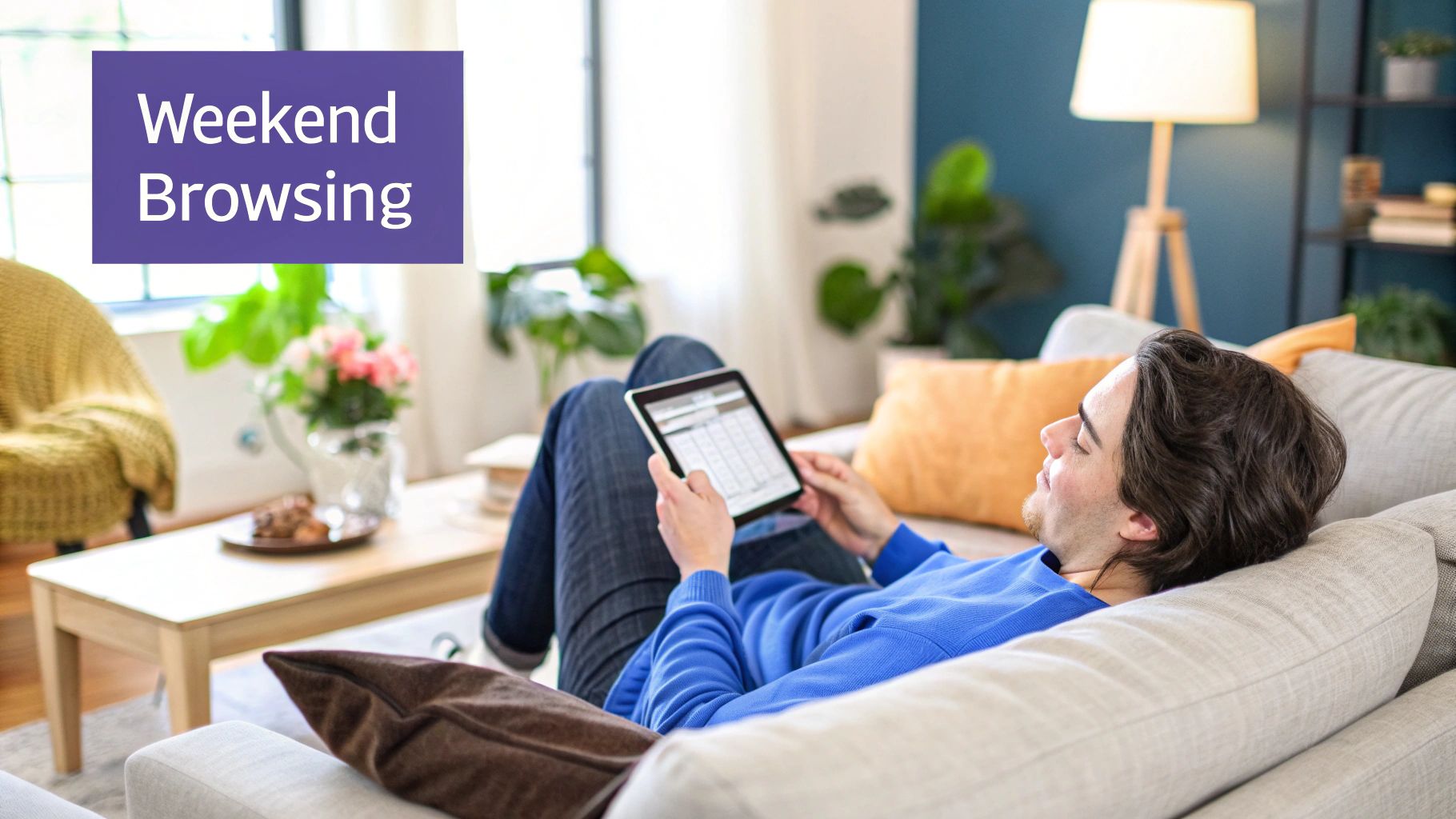
This timeframe has been consistently validated by data from platforms like Later and Iconosquare, particularly for visual platforms like Instagram and Pinterest. Their research shows a distinct shift in user behavior on weekends, where engagement is driven less by professional needs and more by personal interests and hobbies.
Why This Time Slot Works
The effectiveness of the Saturday 9-10 AM window is rooted in psychology and context. Weekday content consumption is often rushed and utilitarian. On weekend mornings, users are in a discovery mindset. They are actively looking for things to do, recipes to try, products to desire, or places to visit. Brands that align their content with this leisurely browsing behavior can build a much deeper, more authentic connection than they can during a hectic workweek. The audience is more receptive, less distracted, and more likely to spend time watching a full video or exploring a detailed post.
Key Insight: Weekend morning posting isn't about interrupting a routine; it's about becoming a welcome part of your audience's leisure time, leading to higher-quality engagement and brand affinity.
Actionable Strategies for Implementation
To succeed in this time slot, your content must feel less like an advertisement and more like a valuable addition to your audience’s weekend.
- Focus on Lifestyle and Inspiration: This is the ideal time for content that inspires action or emotion. Travel brands like Airbnb see huge success posting dreamy destinations, while food bloggers get maximum recipe saves by sharing delicious brunch ideas.
- Leverage High-Quality Visuals: Weekend scrollers are drawn to beautiful aesthetics. Use high-resolution photos, polished videos, and visually appealing graphics. Nike, for example, often posts motivational fitness content and user-generated stories on Saturday mornings to inspire weekend workouts.
- Align Content with Platform Mindset:
- Instagram & Pinterest: These are prime platforms for this time slot. Share DIY projects, home decor inspiration, fashion lookbooks, or wellness tips.
- Facebook: Use this time to build community. Ask engaging questions, run a fun poll about weekend plans, or share a feel-good story that encourages comments and shares.
- Avoid Hard Sells: Steer clear of overly promotional or aggressive sales messages. The goal is to build a relationship, not just to make a sale. Focus on value and connection first.
Consistent scheduling is key to making this weekend slot work for you. Using a tool to plan and automate these posts ensures you never miss the opportunity to engage your audience during their downtime. This allows you to connect with your community even when you’re enjoying your own weekend.
6. Platform-Specific Optimal Windows
Moving beyond a one-size-fits-all schedule, a more advanced strategy involves tailoring your posting times to the unique user behavior patterns of each social media platform. Every network, from LinkedIn to TikTok, cultivates a distinct environment with its own audience habits and algorithmic priorities. Recognizing these differences is crucial for determining the best times to post because an optimal window on one platform may be a dead zone on another. This approach requires a granular, platform-by-platform analysis to maximize reach and engagement.
Digital marketing authorities like Hootsuite and platform-specific research teams have consistently proven that a universal posting schedule is less effective than a customized one. The mindset of a user scrolling LinkedIn during work hours is vastly different from someone browsing Pinterest for inspiration on a weekend, and your timing must reflect that.
This minimalistic bar chart visualizes the distinct peak posting windows for three major social platforms, highlighting the need for a tailored scheduling strategy.
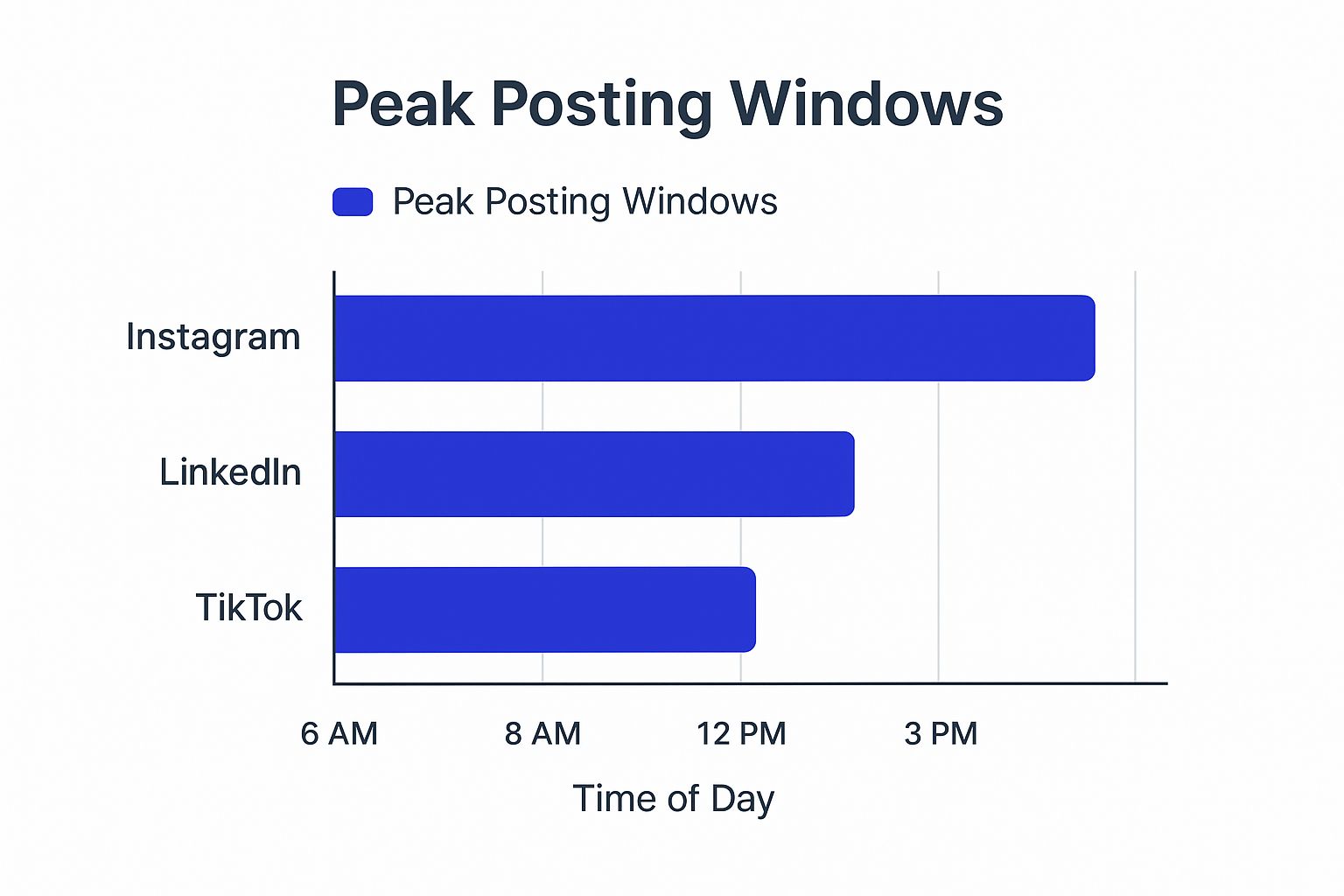
The chart clearly shows there is no single "golden hour" for all social media, with professional, visual, and entertainment platforms peaking at entirely different times of the day.
Why This Time Slot Works
The effectiveness of platform-specific windows is rooted in user intent. People use different social networks for different reasons and at different times. For instance, LinkedIn's peak hours of 8 AM and 5-6 PM align with the start and end of the professional workday, when users check in for industry news and career updates. Conversely, TikTok's peak engagement often occurs later in the evening, as users unwind with short-form entertainment. By aligning your posts with these inherent behavioral rhythms, your content feels more native and less disruptive, increasing its chances of being seen and engaged with.
Key Insight: The best time to post is not a universal constant; it's a variable that changes with each platform's unique audience culture and content consumption habits.
Actionable Strategies for Implementation
To successfully implement a platform-specific strategy, you must treat each social channel as a separate campaign with its own timing rules.
- Leverage Platform-Native Analytics: Dive into Instagram Insights, TikTok Analytics, and LinkedIn Page Analytics. These tools provide concrete data on when your specific followers are most active on each platform, removing guesswork.
- Test and Isolate Variables: When testing times, do it for each platform separately. Schedule a B2B case study on LinkedIn at 9 AM on Tuesday and a behind-the-scenes video on Instagram at 1 PM on the same day. Compare results within each platform, not between them.
- Adapt Timing to Content Format: A quick, trending audio clip on TikTok might perform best at 7 PM, while a detailed, thought-provoking carousel on Instagram may see better engagement around lunchtime when users have more time to swipe.
- Align with Platform Mindset:
- LinkedIn: Optimal times are typically Tuesday-Thursday mornings (8-10 AM) for professional content.
- TikTok: Peak engagement is often seen in the evenings (6-9 PM) and mornings (9 AM) when users are looking for entertainment.
- Pinterest: Users are often in a planning mindset, leading to high activity on Tuesday-Saturday mornings.
Managing multiple, unique schedules can be complex. You can dig deeper into platform-specific data with our guide on the best time to post on social media. Using a tool like PostSyncer allows you to set distinct, optimized schedules for each profile, ensuring every post goes out at the perfect moment for that specific platform.
7. Audience Analytics-Driven Timing
While general time slots provide a strong starting point, the most advanced and effective strategy is to move beyond industry benchmarks and listen directly to your own audience. An analytics-driven approach uses your platform's native insights, third-party tool data, and audience behavior metrics to pinpoint the best times to post specifically for your unique followers. This data-first methodology transforms scheduling from a guessing game into a precise, continuously optimized science.
This strategy was pioneered and popularized by data-driven marketing leaders like Google and Facebook, who built their empires on understanding user behavior. Today, thought leaders like Gary Vaynerchuk and Mari Smith champion this hyper-personalized approach, urging marketers to trust their data above all else. It’s a powerful method because it’s tailored to the distinct habits and digital routines of the people who actually follow and engage with your brand.
Why This Time Slot Works
The power of analytics-driven timing lies in its specificity. Generic posting times are based on averages that lump together diverse audiences, industries, and time zones. Your audience is not an average; it's a specific group with unique behaviors. By analyzing when your followers are most active, commenting, and sharing, you align your content delivery with their peak attention windows. This precision leads to significantly higher initial engagement, which signals to platform algorithms that your content is valuable, boosting its organic reach and long-term visibility. E-commerce brands, for instance, can analyze purchase data to time product announcements, while creators use YouTube Analytics to schedule uploads exactly when their subscribers are most likely to watch.
Key Insight: The ultimate "best time to post" isn't a universal time slot; it's a dynamic window of opportunity revealed by your own audience's data.
Actionable Strategies for Implementation
To harness the power of your data, you must adopt a systematic process of testing and refinement.
- Start with Native Analytics: Dive into the "Insights" or "Analytics" tabs on Instagram, Facebook, TikTok, and LinkedIn. These tools show you the exact days and hours your followers are most active. This is your baseline.
- A/B Test Posting Times Systematically: Don't just post randomly. Schedule identical or similar types of content at different high-activity times (e.g., Tuesday at 6 PM vs. Tuesday at 8 PM) and track performance. Note which slot generates more engagement over several weeks.
- Track Deeper Metrics: Go beyond likes. Monitor shares, comments, saves, and click-through rates. These metrics are stronger indicators of genuine interest and help you understand what content resonates most at specific times.
- Consider Audience Lifecycle and Seasonality: A new follower's behavior might differ from a long-term advocate's. Likewise, seasonal trends, holidays, or major events can temporarily shift online habits. Adjust your schedule accordingly.
Using a comprehensive tool is crucial for gathering and interpreting this data effectively. You can learn how to centralize and analyze these metrics with our guide to building a social media analytics dashboard. By committing to a data-driven strategy, you ensure your content consistently reaches the right people at the perfect moment.
Best Times to Post: 7-Point Comparison
| Strategy | Implementation Complexity (🔄) | Resource Requirements (⚡) | Expected Outcomes (📊 ⭐) | Ideal Use Cases (💡) | Key Advantages (⭐) |
|---|---|---|---|---|---|
| Peak Commute Time Posting (7-9 AM) | Medium 🔄 (requires early scheduling) | Moderate ⚡ (planning and timing tools) | High engagement, attention, visibility 📊⭐ | News, motivational, educational content | Captures alert audience; lower competition; global reach |
| Lunch Break Engagement (12-1 PM) | Low-Medium 🔄 (short window, time zones) | Moderate ⚡ (content must be concise, visual) | Reliable mid-day engagement, quick content consumption 📊⭐ | B2B, lifestyle, promotional content | Consistent engagement; good for promotions; mix of device use |
| Evening Wind-Down (6-8 PM) | High 🔄 (high content quality needed) | High ⚡ (high-quality videos, live streams) | Longer engagement sessions, higher conversion rates 📊⭐ | Video content, e-commerce, entertainment | Best for video/live streams; strong user interaction |
| Tuesday-Thursday Sweet Spot | Low 🔄 (scheduling within specific weekdays) | Low ⚡ (batch content creation possible) | Consistent engagement, higher professional availability 📊⭐ | B2B, educational, campaign launches | Most reliable midweek engagement; reduced weekend noise |
| Weekend Leisure Browsing (Sat 9-10 AM) | Low 🔄 (simple scheduling) | Low ⚡ (focus on lifestyle content) | Higher lifestyle and inspirational engagement 📊⭐ | Lifestyle, entertainment, user-generated content | Engaged leisure audience; good for UGC and inspiration |
| Platform-Specific Optimal Windows | High 🔄 (multiple schedules, constant updates) | High ⚡ (analytics and platform-specific tools) | Optimized engagement per platform, better reach 📊⭐ | Cross-platform marketing, multi-format content | Max ROI from tailored timing; algorithm alignment |
| Audience Analytics-Driven Timing | Very High 🔄 (data analysis intensive) | Very High ⚡ (analytics tools and expertise) | Personalized, highly optimized engagement 📊⭐ | Any with access to analytics; tailored campaigns | Most precise; adaptable; measurable ROI |
Automate Your Perfect Timing with PostSyncer's AI
Mastering the art of timing on social media isn't about memorizing a static list of hours. As we've explored, the best times to post are a dynamic blend of general human behavior, platform-specific nuances, and, most critically, your unique audience's habits. The real takeaway is that while universal patterns like commute times, lunch breaks, and evening relaxation provide a strong foundation, true optimization is a continuous, data-driven process.
Generic advice is a starting point, not a destination. Your audience in New York might have a completely different lunch break routine than your followers in London. Your B2B content will almost certainly find its sweet spot on LinkedIn during midweek work hours, while your B2C e-commerce brand might see explosive engagement on Instagram during late-night "revenge bedtime procrastination" scrolls. The key is to move from broad assumptions to specific, actionable intelligence derived from your own performance data.
From Manual Analysis to Intelligent Automation
The challenge for any marketer, agency, or creator is the sheer effort required for this level of precision. Manually tracking engagement, cross-referencing times across different platforms, and adjusting schedules based on performance is not just time-consuming; it's a significant barrier to focusing on what truly matters: creating compelling content. This is where strategic implementation separates the successful from the overwhelmed.
Key Insight: The most effective social media strategies don't just rely on knowing the best times to post; they rely on consistently and efficiently executing on that knowledge.
This transition from manual guesswork to automated precision is the single most impactful step you can take to elevate your social media presence. Imagine knowing with certainty that your TikTok video is going live at the exact moment your target demographic is most active, or that your LinkedIn article is hitting inboxes when key decision-makers are checking their feeds. This isn't a luxury reserved for massive corporations; it's a capability now accessible through intelligent tools. To truly automate your perfect timing and maximize efficiency, exploring comprehensive social media automation with AI solutions can be highly beneficial.
Your Actionable Path Forward
Let's distill this entire discussion into a clear, strategic workflow that you can implement today:
- Establish Your Baseline: Use the general peak times discussed, like the Tuesday-Thursday sweet spot and commute-hour windows, as your initial scheduling framework. This gives you a data-supported starting point.
- Activate Your Analytics: Dive deep into each platform’s native analytics. Go beyond surface-level metrics and pinpoint the specific hours and days your followers are most active and engaged.
- Test and Segment: Don't treat all content equally. Test different timings for different content pillars. Does your educational content perform better mid-morning, while your entertaining behind-the-scenes posts excel in the evening?
- Embrace AI-Powered Scheduling: The ultimate step is to let technology do the heavy lifting. Instead of spending hours in spreadsheets trying to find the best times to post, leverage a tool that analyzes your specific account performance and automates the process.
By adopting this mindset, you transform posting from a reactive chore into a proactive strategy. You stop throwing content at the wall and hoping it sticks; instead, you place each piece of content in the optimal position to capture attention, drive engagement, and achieve your marketing goals. Your time is your most valuable asset. Automating the science of timing frees you to invest that time in the art of creation.
Ready to stop guessing and start leveraging data-driven precision? PostSyncer analyzes your unique audience activity to automatically determine the absolute best times to post for you. Sign up for PostSyncer today and let our AI ensure every single post achieves maximum impact, so you can focus on creating content that connects.
